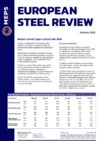EU steel industry faces supply and demand challenges
Balancing supply and demand will continue to prove a challenge for Europe’s steel industry despite forecasts that 2024 could mark the start of a turnaround.
According to worldsteel’s latest short-range outlook report, this year will bring a 2.9% increase in demand. The uptick would end two years of decline after 2023 brought Europe’s lowest level of annual steel demand since the year 2000. Furthermore, worldsteel’s forecast indicates that this will be followed by a further 5.3% rise in 2025, when EU steel consumption will grow to 148.1m tonnes.
Despite its current economic difficulties, and increasingly negative sentiment among respondents to research for MEPS's European Steel Review this month, Germany is expected to remain among the world’s top 10 steel-consuming regions. The report forecasts that German steel consumption will rise by 3.2% in 2024, to 28.9m tonnes, before rising by 10% in 2025, to 31.8m tonnes.
Much of Europe’s projected growth in consumption is attributed to green infrastructure developments. Estimates indicate that global steel demand for new wind energy installations alone will triple to around 30m tonnes by 2030, compared with the early 2020s.
EU steelmakers require ‘level playing field’
At Eurofer’s recent conference, The Future of EU Industry: Resilience or Dependence, panellists were asked whether the cost of decarbonisation was partially to blame for some of the European steel industry’s issues, however. Eurofer vice president Timoteo di Maulo said that, as investments in lowering emissions grow, legislation would need to ensure that its steelmakers operated on a “level playing field” with cheaper imports.
Eurofer’s di Maulo highlighted the United States' imposition of Section 232 import tariffs and the Inflation Reduction Act to support its domestic industry. He also said that China was decisive in establishing its economic plan and a subsidised steel sector.
A new study from the OECD Steel Committee showed that every USD1m of subsidies through grants from non-OECD states had resulted in capacity increases of between seven and 11 million tonnes.
The OECD suggested that up to 158m tonnes of new capacity may come on stream by 2026. Around 60% of that capacity growth is expected to take place in East Asia, it said.
Attempts to balance the market
Alongside the growing influence of CBAM, changes are expected to be made to the EU’s import safeguard measures, this summer, to mitigate the volume of overseas steel imports. In April, quarter two’s ‘other countries’ hot rolled coil quota was once again filled in the first few days of the new trading period.
Despite the abundance of imports, many of MEPS’s European respondents indicate that domestic capacity cuts would benefit the market. In the short term, reduced production would ease the current downward pressure on European steel prices in a sector suffering from weak demand.
Thyssenkrupp is already planning a more long-term solution to Europe’s lower levels of demand. The German steelmaker has announced plans to reduce the production capacity at its Duisburg site from 11 million tonnes to between nine and 9.5 million tonnes. It cited high energy costs, which would continue to rise due to climate policy objectives, along with “unbridled increasing import pressure, predominantly from Asia”, in making its decision.
The revised level is in line with its shipping volumes for each of the past three years. There is currently no indication of how many jobs might be affected.
- This content first appeared in the March edition of MEPS International's European Steel Review. The monthly report provides subscribers with steel prices and indices, market commentary and steel price forecasts from across Europe.

Source:
European Steel Review
The MEPS European Steel Review is an informative, concise and easy-to-use monthly publication, offering unique professional insight into European carbon steel prices.
Go to productRequest a free publication





